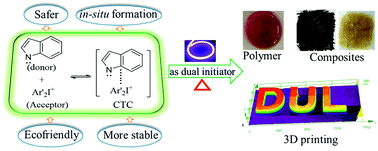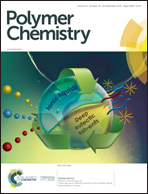Indole-based charge transfer complexes as versatile dual thermal and photochemical polymerization initiators for 3D printing and composites†
Abstract
Charge Transfer Complexes (CTCs) have recently been featured as new dual photo/thermal initiators, with attractive initiating features, such as in situ formation, high stability, spatiotemporal control, highly efficient process at room temperature (for the photochemical mode), reduced emissions of volatile organic compounds (VOCs) and high robustness in additive manufacturing and composite manufacturing. Extending the concept, in the present work, a series of CTCs formed between indoles (donors) and iodonium salt (acceptor) are investigated as safer and more stable dual thermal and photochemical free radical polymerization (FRP) initiators for benchmarked methacrylates. The formation of the CTCs is evaluated theoretically by Molecular Orbital (MO) calculations and experimentally using UV-vis spectroscopy. Remarkably, due to the in situ formation, safer storage ability as thermal initiators compared to traditional thermal initiators is demonstrated. As an additive manufacturing proof of concept, laser write experiments @405 nm show excellent spatial resolution performances. Dual approaches (photo/thermal curing) were also used to efficiently initiate both polymerization processes for the curing of glass fiber or carbon fiber composites, e.g. fast curing by light of the surface associated with a dark thermal curing in depth.



 Please wait while we load your content...
Please wait while we load your content...